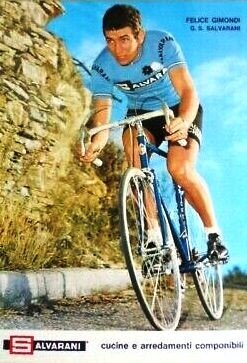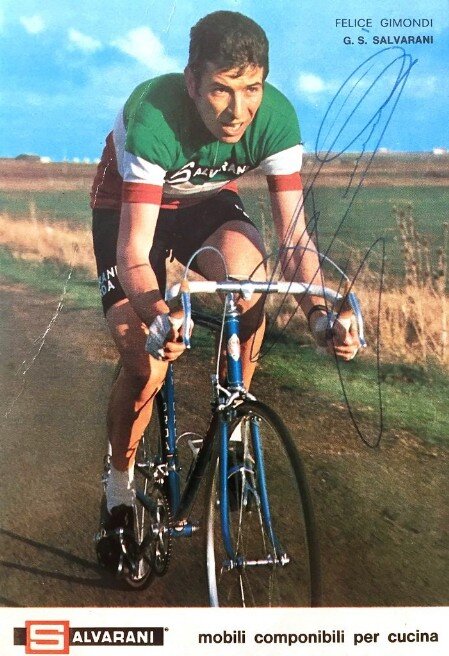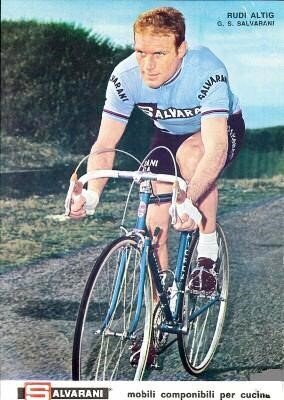Chiorda
Storia di Chiorda

Sono i primi anni del '900 quando ad Albino (BG) i tre figli del farmacista Carlo, Vito, ed Ettore Chiorda fondano la Cicli Chiorda. Nel 1906 il giovane corridore dilettante Ettore Noris Chiorda su una bicicletta uscita dalla sua officina vince il campionato sociale UCB, in seguito gareggerà contro campioni come Giovanni Gerbi e Costante Girardengo e parteciperà al Giro d'Italia del 1922". La produzione inizialmente è ad Albino (Bergamo). Il campanile che compare nel marchio Chiorda è, infatti, quello di Piazza Vittorio Veneto a Bergamo. Negli anni sessanta la Chiorda diventa proprietà di Angelo Trapletti - un industriale bergamasco che acquisirà anche la Bianchi - che sposta la produzione a Vigano San Martino (Bergamo). Il colore, che rimarrà caratteristico delle Chiorda, è un blu-azzurro. La Chiorda è resa famosa dall'abbinamento con la squadra Salvarani (attiva nel periodo 1962-1972), per la quale hanno corso corridori del calibro di Arnaldo Pambianco, Vito Taccone, Vittorio Adorni, Felice Gimondi, Gianni Motta, Gino Zandegù, Rudy Altig, Marino Basso (che su una Chiorda vince il Campionato del Mondo del 1972 a Gap). In realtà, come accadeva usualmente in quel periodo, le bici dei corridori Salvarani non erano prodotte materialmente negli stabilimenti della Chiorda. I corridori, in particolare quelli di alto livello, potevano servirsi dei telaisti di loro fiducia, che realizzavano biciclette poi verniciate e marchiate Chiorda (come ha ricordato anche Pietro Piazzalunga, allora meccanico della Salvarani). In genere le biciclette della Salvarani, anche le Chiorda, venivano dal Reparto Corse della Bianchi; spesso, però, anche il Reparto Corse della Bianchi si limitava alla verniciatura, al montaggio dei componenti e all'apposizione del marchio su telai realizzati da telaisti di fiducia del corridore. Hanno realizzato telai per la Salvarani De Rosa, Colnago, Mondonico e sembra anche Masi.

They are the first years of the 1900s when in Albino (BG) the three sons of the pharmacist Carlo, Vito, and Ettore Chiorda founded the Cicli Chiorda. In 1906 the young amateur racer Ettore Noris Chiorda on a bicycle that left his workshop won the UCB social championship, later he competed against champions such as Giovanni Gerbi and Costante Girardengo and participated in the 1922 Giro d'Italia. "The production is initially in Albino (Bergamo). The bell tower that appears in the Chiorda brand is, in fact, that of Piazza Vittorio Veneto in Bergamo. In the sixties the Chiorda became the property of Angelo Trapletti - an industrialist from Bergamo who also acquired Bianchi - who moved the production to Vigano San Martino (Bergamo). The color, which will remain characteristic of the Chiorda, is a blue-blue. The Chiorda is made famous by the combination with the Salvarani team (active in the period 1962-1972), for which runners of the caliber of Arnaldo Pambianco, Vito Taccone, Vittorio Adorni, Felice Gimondi, Gianni Motta, Gino Zandegù, Rudy Altig, Marino Basso (who on a Chiorda wins the World Championship of 1972 in Gap). In reality, as usually happened at that time, Salvarani racers' bikes were not materially produced in the Chiorda plants. The riders, especially the high-level ones, could use the frame builders they trusted, who made bicycles that were then painted and branded Chiorda (as Pietro Piazzalunga, then a mechanic at Salvarani also mentioned). In general Salvarani bicycles, also the Chiorda, came from the Bianchi Racing Department; often, however, also the Bianchi Racing Department was limited to painting, assembling the components and affixing the mark on frames made by the runner's trusted frame builders. They made frames for Salvarani De Rosa, Colnago, Mondonico and it also looks like Masi.








